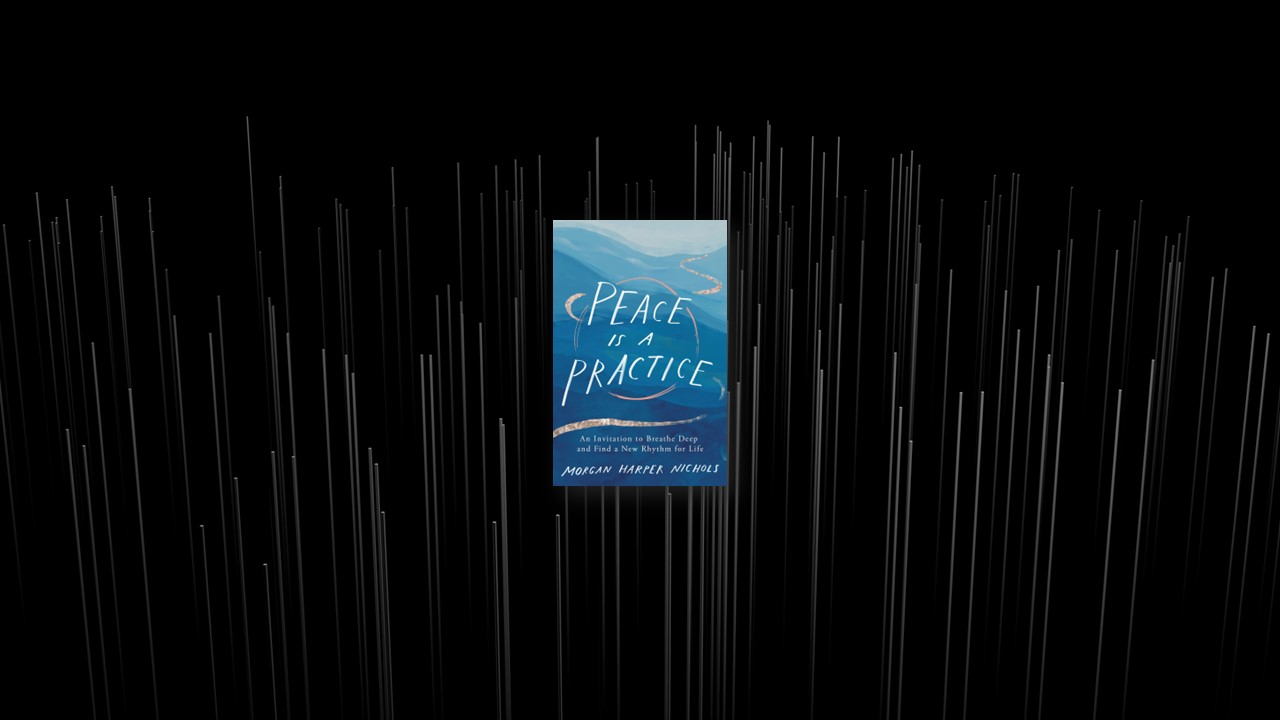Peace Is a Practice
Peace is a state of mind, heart, body, and soul. It is the freedom to breathe, even in the face of great challenges and chaos. Peace is the river in the desert, not on the other side of it.
This book is about learning to seek peace in daily life. It’s about realizing we are worthy of peace. And it starts right here: with a deep inhale and a hold-nothing-back exhale as you ground yourself in the grace of the present. You don’t have to arrive at your picture-perfect life before you can know peace. The river is here for you now, wherever you are.
Shadow and Light
Learning how to make use of shadow and light can make all the difference in how we perceive an image. Black-and-white photography is a great example of this. We don’t even have to see a scene in full color for our minds to make sense of where the shadows and light are, and as a result, we are able to understand what’s happening in the image.
What I love about this concept is that the artist doesn’t ignore the shadows. They work with them. The photographer doesn’t completely avoid the trees. Instead, they work their subject through the shadows and into the light. They notice where the light pours in through the leaves. Then they play with the shadows of the leaves beneath their feet. Whether a painter, photographer, or filmmaker, they work with light to capture the image, but they don’t avoid the shadowy corners.
When it comes to practicing peace, we may want to avoid the shadows. We long for the light-woven moments, and it’s sometimes hard to see the value in the darker ones.
If only we could see the sunset without that big tree in the way.
If only we could have a nice Saturday afternoon without anyone interrupting.
If only we could have world peace and a healthy planet without having to talk about politics.
Instead of looking for light only as a way to avoid the shadows, what if we were willing to accept the whole picture? What if we deliberately spent time with those colors that don’t scream “joy” like yellow or “love” like red? What if practicing peace is slowing down and realizing there’s more to see?
This doesn’t mean we can’t look where the sunlight pours in. This doesn’t mean we can’t paint with bold colors or long for the day that we are able to watch a sunrise without power lines in the way. It just means that perhaps we can still breathe deep and make the most of where we are, even if it doesn’t look exactly how we hoped or planned.
We don’t have to understand everything before we hold both shadow and light.
We don’t have to eliminate every unknown before we take action.
We don’t have to get rid of the darkness to see where the stars shine through.
PRACTICING PEACE IS NOT:
“Everything’s okay! I promise!”
“I’ll be fine. Don’t worry about me.”
“I just want everyone to be happy.”
“I won’t mention what bothered me . . . I’m just trying to keep the peace.”
“I’ll just stay out of politics.”
PRACTICING PEACE IS:
“It’s hard to say this, but I’m not okay.”
“It’s not easy for me to ask, but I do need help.”
“I can no longer live to please everyone.”
“I will courageously pursue a safe space to speak directly about what I’m feeling right now.”
“I am equipped to have hard conversations, knowing even those moments are wrapped in grace. When I choose to be present, there is room for learning, growth, healing, and restorative justice.”
Practicing peace is the willingness to go beyond initial reactions and get down to the ones that remind us that, amid our fears, the river still flows. Practicing peace is realizing that even when we struggle to open up, bringing those honest feelings and thoughts into the light matters. There’s a whole range of emotions between “everything’s fine” and “everything’s terrible.”
Wholeness
See Ourselves in a Different Way
We embrace wholeness by making connections, by realizing that our strengths and weaknesses inform one another. Let us keep connecting to what is beautiful even when we don’t feel beautiful ourselves. We may not be sure how to feel about our own stretch marks, but we have learned to admire the stretch marks of the tall oak tree. It may take time and grace for us to see ourselves in the same way, but by seeing the beauty of a God-fingerprinted tree, unafraid to stretch with the years and become who she was meant to be, we are well on our way. We learn to see that the same light that shines on that tree shines on us too. Let us keep connecting to nature. Let us keep admiring what is beautiful around us even when it’s hard to see it within ourselves, and in time we will discover that we are worthy of the same grace we extend to the tree. We are not fragmented. We are whole. It takes time to remember, but it’s true.
See Our Stories in a Different Way
Of course, we could spend all our time thinking about what could have happened differently. Or instead, we can consider what we have learned and how we can carry it with us into the future. Remember that our stories are a cycle, and when we wish we could have done something differently, as long as we’re living, it’s not too late to circle back, having learned more than we knew before. When we face adversity again, we will face it with new wisdom. We learned from the past. We will know what to do.
Recognize That Our Struggles Can Help Those Who Have Similar Struggles
Sharing our struggles is difficult because in that moment, we’re choosing to go deeper. We choose to let people deeper into our stories, which can make us feel uncomfortable. We may even fear that letting people see our deeper selves might mean that we’re opening ourselves to possible pain and rejection. However, when we choose to be vulnerable, we open up opportunities for connection with others who seek to do the same. This affinity doesn’t always happen right away, and that’s okay. In time, the right person will be grateful that you chose to share. They will be on the receiving end of your learning to embrace the wholeness of your story—even the difficult parts. And when you choose to go deeper by sharing your struggles, you help them to go deeper too.
Letting It Out
Whether what we’re holding in is small or great, we have to practice letting it out. We have to practice breathing deep. It’s difficult work, but for the sake of our collective and individual safety and well-being, it’s worth it.
Practice Peace by Speaking Up
Sometimes it will take everything within us to speak up. Telling the truth may require the longest, most mindful exhale we’ve ever released. For victims and survivors of abuse and violence, it takes great courage to speak up, to talk about something that never should have happened in the first place. It can’t be said enough: speaking up matters. You are worthy of love, support, and justice.
Practice Peace by Not Minimizing Our Hurt
When we consider all the ways people have been hurt, even within our own families and communities, at times we may feel we are not worthy of the same tenderness or care because what others have been through seems more significant. Even when we accept our hurt as valid, we may feel like sharing it with others burdens them or that seeking help will make us look weak. But these are simply not true. Pursuing help may take great courage, but it is always worth it.
Allow Others to Help
Sometimes we may not reach out because those in our immediate circles have dismissed our pain. We may have been legitimately hurt, and yet we’ve been told or made to feel that it’s our fault and our responsibility to make the problem go away. Because of this, we may forget that other people are out there. There are friends, therapists, clergy members, doctors, lawyers, and others who will say “I see you,” and can help you find peace in letting it out—and letting someone in.
Letting It Go
Embrace Humility
Whenever we have something we’re proud of, it becomes a bright light in our lives. But sometimes the brightness can cause us to forget about the shadows. Just because we’re proud of our ability to be creative or to come up with new ideas or to be a leader doesn’t take away the fact that we must leave room for growth. Humility is accepting that even when we feel like we have a good understanding of who we are, we can usually still learn something from those who love us.
Release the Need to Be in Control
Life becomes extra stressful when we remember that we are not in control. This is why we have to practice letting go of our need for control, even in the smallest ways. One of the simplest ways we can do this is by taking a deep breath when we become frustrated with someone or something we can’t control. We can inhale slowly and exhale slowly. Of course this won’t change the outcome or immediately put us in control of the situation, but taking the time to breathe can help us regulate our thoughts and emotions. Then we can see that while we might not be able to control every outcome, we can control our breath. And by controlling our breath, we can carry on, trusting that we can know peace even when we’re not in control.
Free Ourselves from Expectations
When we are finally able to let go of expectations, we are finally able to make room for new ways of thinking. We are able to make room to see that when we were struggling, perhaps we were also growing in strength. When we were challenged by unwanted outcomes, we were also growing in our capacity to feel and express our emotions. Letting go is anything but easy, but we can trust that on the other side there is space to breathe and room to encounter peace beyond our understanding.


